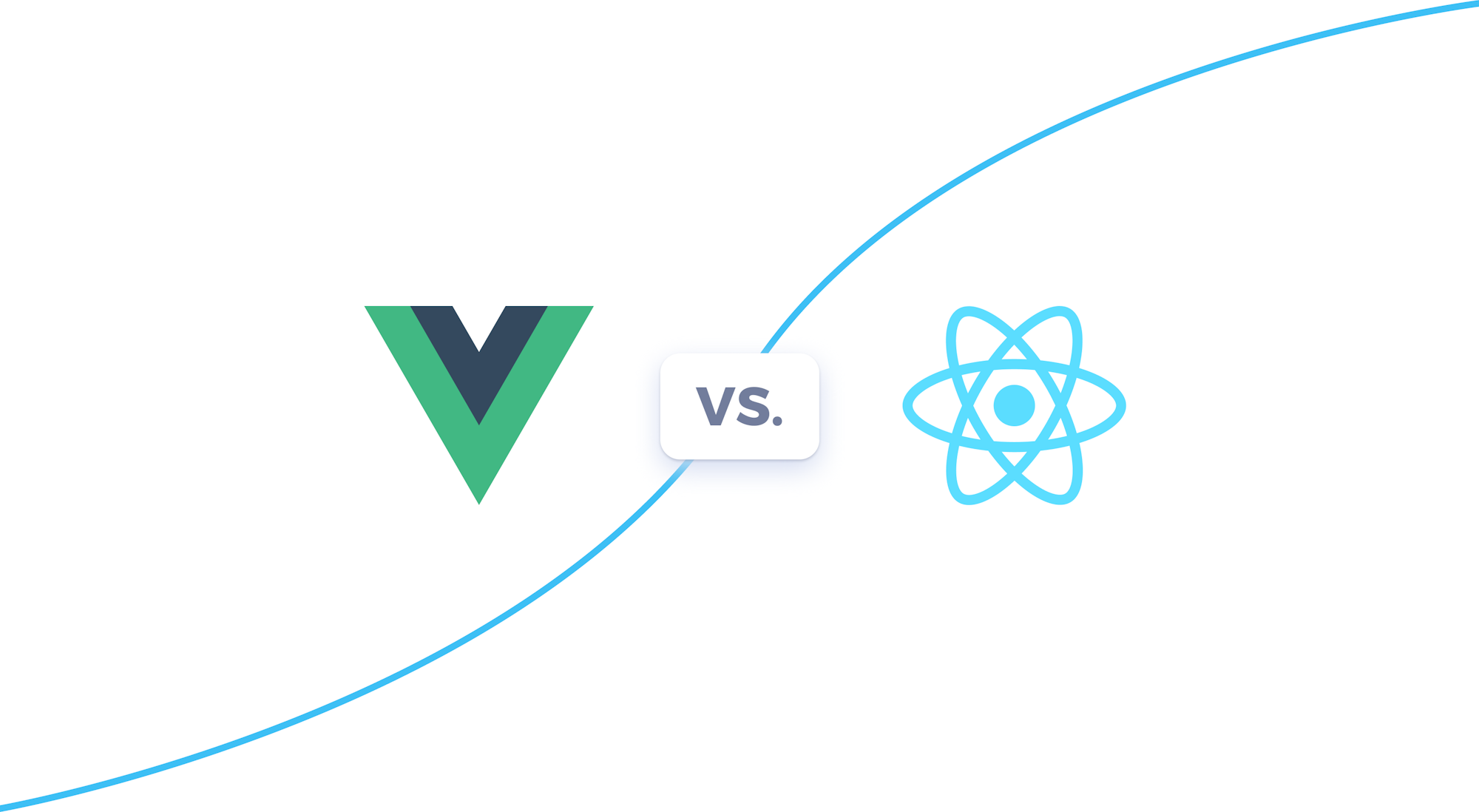- Blog
- Company news
- Vue vs React: Which Is The Best Option in 2021?

Kyle Meagher
March 08, 2021


JavaScript is, by far, the most popular programming language in the world. However, that popularity becomes self-evident when you look at how many libraries and frameworks are built on top of JavaScript.
Vue and React are among the most popular web frameworks(React is 2nd only to jQuery, Vue has risen steadily to the #7 spot). Neither of them appears to be slowing down anytime soon – both gained usage share over the last 3 years.
The distinction that we make between libraries and frameworks is essential to understanding the differences between Vue and React. Although they're both built on top of JavaScript, they have different use cases.
In this article, we'll talk about what Vue and React bring to the table to help you decide which framework/library you should use.
What Is React?
React (also known as React.js or ReactJS) is a JavaScript library developed by Facebook. It was released in 2013 and, since then, it's grown into one of the most popular libraries in the world. If you go by GitHub numbers alone, over 5.8 million developers have projects that use React.
With React, you can build user interfaces using declarative views and encapsulated components. React also took the existing concept of the virtual DOM and made it much more popular in development. Using React virtual DOMs, every time that you render a JSX element (the syntax that React uses) the library detects what objects it needs to update and updates only those resources in the real DOM.
Technicalities aside, it's also important to mention that Vue and React are very different when it comes to core philosophies. React is still maintained and funded by Facebook, but it operates under the MIT license, making it an open-source project.
What Is Vue?
Vue is, in many ways, similar to React. It's an open-source framework designed to help developers build intricate User Interfaces (UI). However, it's the somewhat newer project, launching in 2014. Vue is the thought-child of Evan You, a developer who's still working on the project, albeit with a larger team now thanks to crowdfunding and corporate sponsors.
Despite the evident difference between resources for both projects, Vue has gained steadily in market share and popularity throughout the past few years.
As far as technicalities go, Vue uses the same virtual DOM approach as React. It's also a component-based framework that focuses on the view library. That means it somewhat depends on other libraries for routing and management.
4 Key Differences Between Vue and React
So far, you know what makes Vue and React so similar (and popular). Let's talk about the main differences between them.
1. Templating
Perhaps the most evident difference between React and Vue lies in the way that each project handles templates.
React uses a JavaScript syntax extension called JSX for everything. It's possible to use React without JSX, allowing you to skip compiles by using plan Javascript, but for all intents and purposes, many of the benefits of React are built into JSX.
Using JSX means that both HTML and CSS are wrapped up in JavaScript. In practice, using JSX, you can use the same code to generate both UI components and dictate their behavior.
JSX can be as versatile as a full language, including flow controls and temporary variables. Plus, it supports all the Integrated Development Environment (IDE) features you'd expect, such as autocomplete, linting, and type checking.
Vue, on the other hand, uses distinct blocks for HTML, CSS, and JavaScript. This makes picking up the framework more simple, even if you're relatively new to JavaScript. Vue is a common first framework for developers.
Vue's 'modular' approach also makes it easy to migrate projects to the framework, since you can add functionality gradually to existing documents.
What's more, Vue also supports JSX, making it far more versatile than it looks at first glance. Even so, the framework is primarily designed to work with HTML-based templates, and Vue's own docs recommend against JSX for most cases.
In our experience, many developers feel that JSX is the more comprehensive and powerful option. However, Vue is definitely easier to work with, especially if not everyone on your team is familiar with the framework.
2. Ecosystem
It would be fair to say that Vue is more of a standalone solution than React. Using Vue, you get access to a smaller number of companion libraries simply, because we're dealing with a framework that's not as popular as React. However, you also need external libraries less often, because most of the functionality you need already exists within the framework.
Some of the most important Vue libraries, such as vue-router, are supported by the frameworks' own core team.
React, on the other hand, offers you a staggering number of libraries. In most cases, you'll need to use them since React relies on third-party solutions for state management and routing.
Some of those critical libraries, such as react-redux and react-router are maintained by the community, unlike React core, but are still highly reliable.
3. Scalability
Both Vue and React are lightweight solutions, and they're pretty much on par when it comes to performance out of the box. However, as your web applications start to grow, some cracks begin to emerge.
Vue's HTML template approach may be simpler to adopt, but it can also be a handicap for large projects. Simply put, dealing with HTML templates over and over is not as efficient as using JSX.
React's institutional support and popularity also gives it an edge when it comes to scalability. It's hard to compete with the vast number of libraries available to customize your projects. Combine that with JSX and you have a library that's perfect for enterprise-grade projects.
4. Cross-Platform Development
If you're interested in cross-platform development, React wins the battle hands down thanks to React Native alone. With React Native, you can re-use vast portions of your code between mobile and desktop operating systems, all using React components.
Vue also offers several options for mobile development, but the selection isn't as clear cut as with React Native. Some of the most popular Vue options include Quasar, Vux, and Mint-UI.
In our experience, mobile development with React is generally easier, although Vue isn't lagging that far behind in terms of functionality. React Native's sheer popularity makes it the best choice due to its native functionality, documentation, and third-party solutions.
How Vue and React Work with Headless CMS Solutions
Of course, many solutions built with either React or Vue combine with a headless Content Management System (CMS) solution for content management and increased application accessibility.
Although Vue does offer a more all-in-one solution than React, both can benefit from all the features a headless CMS brings to the table. Using a headless CMS, you can rely on React or Vue for your web application's front end (the head) and let the CMS handle everything else, including:
- Providing a dashboard you and your team can use. Although you may be comfortable dealing with the backend directly, a lot of your team might prefer to use an intuitive dashboard to interact with and update your application content.
- Access to rich text and media editing tools. Text and media are at the core of every web project and having access to a powerful editor will make your life much easier when it comes to publishing and updating your site.
- User role and permission systems. Not every user needs the same level of permissions when it comes to updating applications. With the right CMS, you can govern these settings with a user-friendly interface.
- Backup functionality. Instead of worrying about backing up your data, you can let a CMS do it for you.
Which headless CMS solution you decide to use comes down to feature sets and needs. Cosmic is proudly the most flexible headless CMS available in 2021's market. With Cosmic you get access to both a REST and a GraphQL API to sync data to buckets. And our NPM module is a great fit for any React or Vue application.
Cosmic makes it easy to learn and launch React and Vue projects in a matter of minutes. You can deploy a React app with only a handful of commands, and the same goes for Vue. See the docs for helpful guides to get started with React or Vue.js.
When to Use Vue vs React and Vice Versa
Due to Vue and React's different core philosophies, there are fairly clear best-use scenarios for each solution. To sum them up:
- React. This library is the better option if you're working on an enterprise-level project or you want to pick the solution that has the most options when it comes to third-party contributions. Most importantly, React's basis on JSX can make it a much more scalable option versus Vue's HTML templating.
- Vue. We recommend that you use Vue if you want a framework that makes migrating projects as easy as possible. Vue is also the superior option if you want a framework that makes collaboration simpler, precisely thanks to its HTML templating approach. Overall, it's more beginner-friendly.
Ultimately, which solution you opt for should depend on your team and each project that you tackle. In any case, both React and Vue are fantastic options to work with.
Are you ready to start using React and Vue alongside a headless CMS solution? Start Managing an Application with Cosmic for free right now.
Continue Learning
Ready to get started?
Build your next project with Cosmic and start creating content faster.
No credit card required • 75,000+ developers



